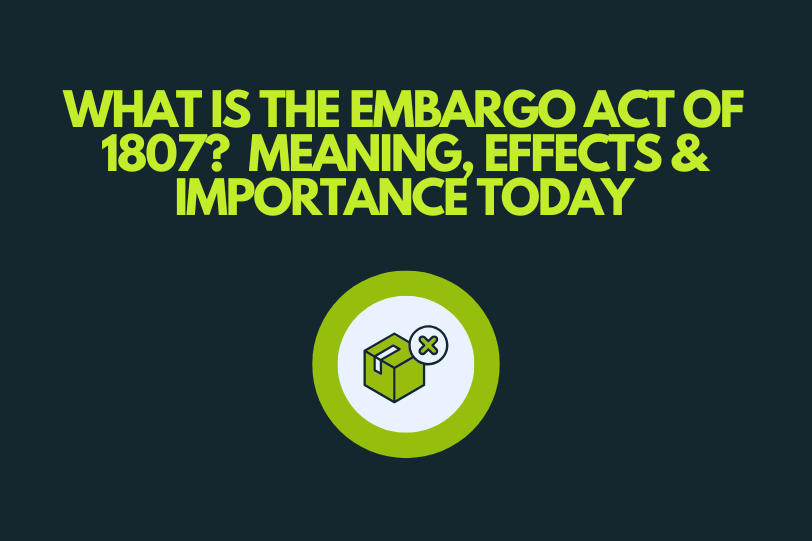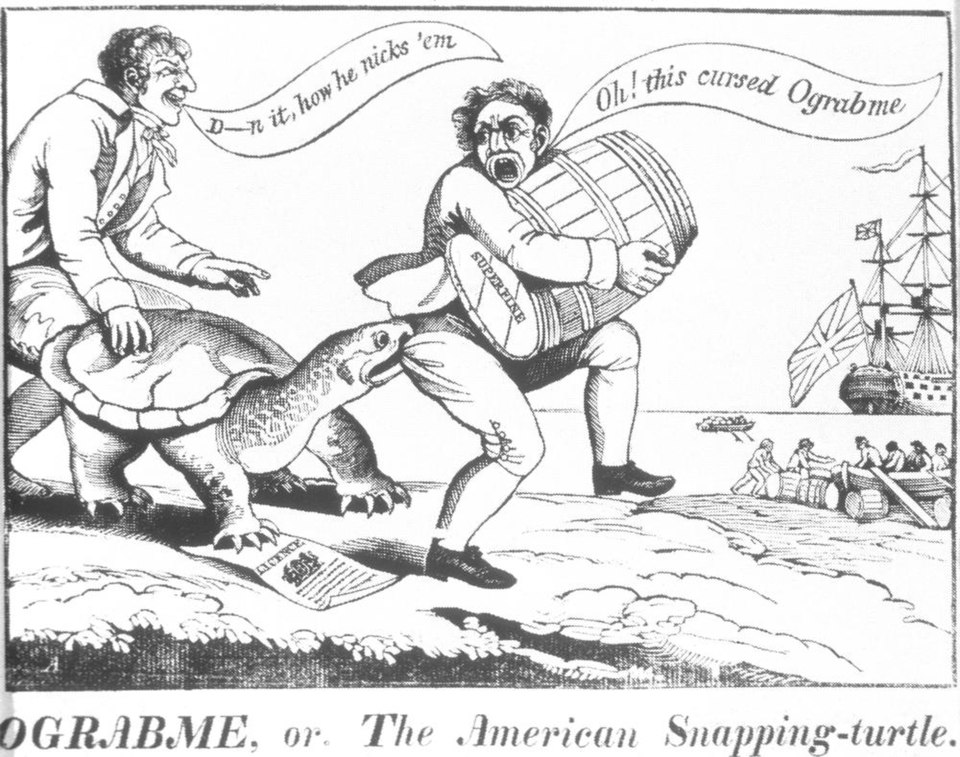
What Is the Embargo Act of 1807? Its Meaning, Effects, and Why It Matters for Compliance Today
Learn about the Embargo Act of 1807—its purpose, impact, and legacy—and discover key lessons and best practices for staying compliant with modern trade and embargo regulations.
An embargo is a government order that restricts or bans trade with one or more foreign nations, often as an instrument of foreign diplomacy or war. Unlike tariffs or quotas, which regulate trade flows, an embargo prohibits them altogether, creating a blunt tool of economic coercion. Over history, embargos have been used to influence rival nations, punish behavior, or signal resolve without resorting to direct military conflict.
Among the most famous embargoes in U.S. history is the Embargo Act of 1807, passed under President Thomas Jefferson. In the early 19th century, the young United States, caught between Britain and France during the Napoleonic Wars, attempted to leverage commerce as diplomatic pressure. The 1807 Act essentially halted U.S. foreign trade in hopes of compelling European respect for American neutral shipping rights. It is remembered today as a bold but flawed experiment in economic statecraft.
This article walks through the context of the Embargo Act, its provisions, enforcement challenges, and consequences. It also reflects on how such a sweeping trade restriction illustrates principles of compliance, and outlines how modern actors (governments, companies, shippers) might “stay compliant” in regimes where embargoes or trade restrictions are in force.
The Embargo Act of 1807: Background and Context
European Wars, U.S. Neutrality, and Maritime Aggression
In the early 1800s, Britain and France were embroiled in the Napoleonic Wars—a conflict that created waves far beyond Europe. Both sides sought to disrupt each other’s commerce, blockading ports and interfering with neutral shipping. The United States, as a neutral maritime trading nation, found itself squeezed. British naval vessels frequently boarded or seized American merchant ships, often claiming that the Americans carried contraband or had British-born sailors aboard who could be “impressed” into Royal Navy service. One particularly notorious incident was the Chesapeake–Leopard affair in June 1807, when the British warship Leopard fired on the American frigate Chesapeake and forcibly removed sailors.
These provocations outraged the American public and Congress, but war was not an easy option given the relative naval weakness of the U.S. President Jefferson and his allies believed that using economic pressure—i.e. cutting off exports—might force Britain and France to respect U.S. rights at sea without bloodshed.

Enactment and Provisions
The Embargo Act was passed by the 10th U.S. Congress and signed into law on December 22, 1807. Its formal title was “An Act laying an Embargo on all Ships and Vessels in the Ports and Harbors of the United States.”
Under the Act:
- American ships and vessels were prohibited from leaving U.S. ports to engage in trade with foreign nations.
- Ships could not clear for foreign voyages or obtain licenses for outbound trade.
- Certain exceptions were allowed at the President’s discretion, especially for vessels under government control or for domestic commerce.
- Violators—shipowners or captains—faced penalties including fines, forfeiture of ship and cargo, and bonds or sureties (i.e. guarantees) for compliance.
- At first, warships were exempted to allow governmental operation.
Shortly after, Congress passed a supplementary act (January 1808) to close some loopholes. It extended bonding requirements to coasting, fishing, and whaling vessels, which had previously operated under exemptions, and expanded penalties for those who tried to circumvent the embargo.
Later still, a further amendment prohibited all exports whether by land or sea (broadening the embargo), and empowered port authorities to seize cargos more aggressively.
In effect, the embargo sought to make American commerce a bargaining chip—in hopes that depriving Britain and France of U.S. goods would force them to ease restrictions on American shipping.
Impact, Challenges, and Repeal
Immediate Economic Effects
While the embargo’s intent was strategic leverage, its effect was deeply felt in the U.S. economy. American exports plummeted. Ports in New England, traditionally reliant on shipping and foreign trade, saw suddenly idle fleets. Farmers in the South found their agricultural exports blocked from overseas markets.
The shortage of imports also drove capital and labor into nascent domestic manufacturing. Particularly in the North, textile and other industries began to expand to replace goods no longer coming from Europe. Thus, one long-term effect was acceleration of American industrial growth.
Economic hardship, however, was widespread. Many merchants, shipowners, and workers lost income. Smuggling became rampant, especially along coastlines and border regions (e.g. via Canada). The measures were deeply unpopular in commercial states.
One estimate suggests the U.S. gross national product fell by about 5% because of the embargo.
Enforcement Hurdles and Political Backlash
The federal government faced a massive enforcement challenge. Customs and revenue officials attempted to inspect, detain, and seize ships, but many merchants evaded detection or operated under false documents. The fact that coasting and fishing vessels were initially exempt further made policing selective.
In congress and across states, opposition grew. In New England especially, merchants and politicians criticized the embargo as overreaching and economically damaging. Some states threatened resistance. The law even gave the President discretion to enforce or grant exceptions, raising constitutional concerns about executive overreach.
By March 1, 1809, having failed to coerce British or French concessions—and with the American economy in distress—Congress repealed the Embargo Act and replaced it with the Non-Intercourse Act, which lifted trade restrictions except with Britain and France.
Further trade acts followed (such as Macon’s Bill No. 2) as the U.S. sought to balance diplomacy, trade, and national interest.
Historical Significance
Though the Embargo Act of 1807 is often judged a failure in its original objective, it was nevertheless a major moment in American trade policy. It signaled that the new nation would attempt to leverage economic power in foreign relations, rather than relying purely on diplomacy or force. Its passage also spotlighted the tension between federal authority and states’ economic interests.
The indirect effects were meaningful: increased domestic manufacturing capacity, heightened awareness of trade-dependency risks, and a precedent for economic sanctions as a foreign policy instrument. In later eras, the concept of embargoes and trade restrictions would evolve into more sophisticated sanction regimes and export controls.
Who Did the Embargo Act Apply To?
The Embargo Act targeted American ships, shipowners, and merchants engaged in foreign trade. If a U.S.-registered vessel attempted to sail to a foreign port or clear customs for export, it fell under prohibition. The Act also affected cargo owners, insurers, and associated logistics firms.
It did not directly regulate foreign ships in U.S. ports (unless involved with American commerce). Warships and government vessels initially had exemptions. Through later amendments, the Act extended its reach to coasting, fishing, and inter-state vessels, narrowing exemptions and increasing bonding requirements.
Though the concept is historical, modern analogues exist. In today’s world, embargo measures or sanctions regimes often target entities, sectors, or countries—requiring companies, shippers, exporters, and financial institutions to stay fully compliant or risk penalties.
How to Stay “Compliant” Under an Embargo (or Trade Restriction) Regime
In today’s regulatory landscape, especially with modern sanctions, export controls, or trade embargoes, compliance is essential. Though no one is directing embargoes for 1807 now, the lessons are instructive.
1. Know the Law & Scope of Prohibition
First, precisely understand which goods, services, or transactions are covered. Embargo regimes often distinguish between full bans, partial bans (e.g. only for certain goods or routes), or licensed exceptions. In 1807, for example, federal law prohibited nearly all foreign commerce by U.S. vessels. Modern trade regimes are more granular.
Once the scope is clear, map which internal operations, partners, or routes could be implicated.
2. Implement Screening & Licensing Controls
In a trade-restricted environment, every export, vessel, or transaction should go through a screening process. That may include:
- Verifying vessel registration, ownership, and cargo
- Checking counterparties, ports, and goods against embargoed lists
- Obtaining necessary licenses or waivers from government authorities
- Maintaining bonds or sureties (similar to the 1807 requirement for ships) for compliance
{{snippets-guide}}
3. Track Changes & Stay Updated
One major weakness of the 1807 Act was the challenge of updating exceptions, scrutiny, and enforcement in real time—leading to confusion and evasion. In modern systems, trade compliance teams must monitor updates to embargo sanctions, regulatory lists, and trade law changes. Automated alerts, regulatory feeds, and legal counsel are essential.
4. Documentation & Audit Trails
For enforcement or audit purposes, you must document decisions—why a license was approved or denied, how a vessel cargo was screened, and what exemptions were granted. Just as 19th-century customs officers documented seizures, modern compliance requires strong internal controls and recordkeeping.
5. Monitor for Evasion & Risk
Smuggling was rampant during the Embargo Act era; today, companies must be vigilant for indirect routes, re-routing, transit through third countries, or mislabeling of goods. Ongoing monitoring of trade flows, partner activity, and suspicious patterns is required.
6. Escalation & Governance
Establish a clear escalation path—a compliance officer, legal team, and senior management should weigh high-risk cases. In 1807, the President had discretionary authority to grant exemptions. Modern regimes often allow authorized bodies to license or waive restrictions. But those decisions must be centrally governed, transparent, and defensible.
Lessons from the Embargo Act for Modern Trade & Compliance
- Economic coercion has limits. The Embargo Act’s failure showed that trying to force policy changes via trade disruption risks self-harm if you lack scale or enforcement capacity.
- Enforcement is as critical as law. Without strong mechanisms and oversight, restrictions will be ignored.
- Local resistance matters. Coastal states, merchants, and regional economies exert political pushback; policies must account for domestic interests.
- Adaptability is key. The multiple amendments to the Act show that rigid initial design may fail; flexibility to refine is necessary.
- Trade tools evolve. The Embargo Act was an early precursor to modern sanctions, export controls, and embargo regimes; modern compliance draws from that legacy.
Embargo Act of 1807 in Modern Regulation Discourse
While the Embargo Act is a historical case, its logic resonates in modern trade sanctions and export-control regimes. Governments today may embargo entire sectors (e.g. energy, defense), restrict exports of sensitive technologies, or freeze trade relations with particular nations.
Corporate actors—exporters, logistics providers, financial intermediaries—must keep robust compliance frameworks to navigate these regimes. That includes negative news screening (to identify politically problematic entities), sanctions/PEP screening, licensing workflows, trade control analyses, and strong audit disciplines.
Thus, studying the Embargo Act offers not just historical insight but a lens into how trade policy and compliance policy intersect—how governments try to coerce behavior through commerce, and how compliance must respond.
Conclusion
The Embargo Act of 1807 remains a fascinating episode in American history—a radical attempt to wage economic warfare instead of bullets. While it failed to coerce British or French behavior, it reshaped U.S. trade, fueled domestic industry, and left a lasting legacy in how the young nation thought about commerce as power.
From a compliance lens, the Embargo Act illustrates classic challenges: designing enforceable rules, preventing evasion, calibrating exception regimes, and documenting decisions. Modern embargoes, sanctions, and trade controls inherit those same demands—only with far more complexity in goods, geography, and regulatory frameworks.
For any participant in international trade today—exporters, shippers, carriers, compliance officers—staying current, vigilant, and procedurally rigorous is the only path to compliance. Understanding the past strengthens our ability to navigate the present.
{{snippets-case}}
sanctions.io is a highly reliable and cost-effective solution for real-time screening. AI-powered and with an enterprise-grade API with 99.99% uptime are reasons why customers globally trust us with their compliance efforts and sanctions screening needs.
To learn more about how our sanctions, PEP, and criminal watchlist screening service can support your organization's compliance program: Book a free Discovery Call.
We also encourage you to take advantage of our free 7-day trial to get started with your sanctions and AML screening (no credit card is required).



